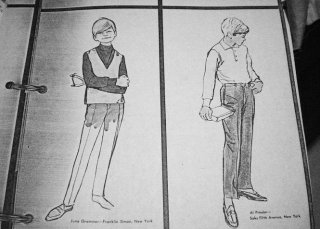You are using an out of date browser. It may not display this or other websites correctly.
You should upgrade or use an alternative browser.
You should upgrade or use an alternative browser.
Children Sketches and Illustrations
- Thread starter VaneB
- Start date
mhhhhhhhhh... no... i'm searchin for fashion sketches like these http://intrendwedding.files.wordpress.com/2009/12/fashion-design-sketch-1.jpg but for children (here in italy we call them FIGURINI  )
)
I'm studying fashion design here in italy but all the books i have present only woman sketches..
 )
)I'm studying fashion design here in italy but all the books i have present only woman sketches..

gius
Active Member
- Joined
- Jan 8, 2006
- Messages
- 10,854
- Reaction score
- 12
here are two, for preteen
when illustrating children, choose a pose that's typical for the age group. also think about personality. i used to have ones of 3-6 yrs old and they were shown playing with a few toys (letter blocks), catching bugs.
photos by me
Thank you! In fact, in particular i need some sketches of infants and 4-5 years old children

gius
Active Member
- Joined
- Jan 8, 2006
- Messages
- 10,854
- Reaction score
- 12
you're welcome
I think this will help so you can design your own...
from idrawdigital.com
The ones I have of the children that age, the tops of their bodies are cut off I just have their legs.. I remember the drawings looked a lot like Kate Greenaway's style. I think muxu has a good point about checking children's books.
I just have their legs.. I remember the drawings looked a lot like Kate Greenaway's style. I think muxu has a good point about checking children's books.
I think this will help so you can design your own...
In the previous drawing post, I touched upon the differences between males and females when attempting to draw correct proportions. This time around, we’re going to look at the differences in the human form as it progressively ages.
We all know that a small child is not built to the same proportions as a grown man/woman – so in order for your drawing to accurately represent a human in all walks of life, you need to understand the ratios for those specific age groups.
Proportions between adults and children
Note the following proportion differences:
- Adult = 8 heads tall, with a head size of 9 inches
- 15 year old = 7 1/2 heads tall with a head size of 9 inches
- 10 year old = 7 heads tall with a head size of 7 1/2 inches
- 5 years old = 6 heads tall with a head size of 7 inches
- 3 years old = 5 heads tall with a head size of 6 1/2 inches
- 1 year old = 4 heads tall with a head size of 6 inches
According to Andrew Loomis, the creator of this chart from Figure Drawing for All It’s Worth – there is a gradual increase in the size of the head of about 3 inches from a toddler to an adult. As the body progresses to shape itself, you’ll note that the legs of the subject will extend at about twice the rate of the torso. These heights are all relative, but act as a great guide for creating proper proportions for a man, woman and child if they are all in the same viewing area.Try out the following exercise:
You should now understand the concept of proportions and have a better grasp of creating realism through the use of varying sizes and shapes and body types of the human form. Check back for my next entry which will deal with proportions in relation to space/perspectives.
- Much like the previous entry on proportion, do some freehand sketches to note the difference between a child’s proportions and an adult’s proportions. Remember the number of head units needed for each.
- Try an anterior, posterior and lateral set of views.
- Remember to modify the look of the young child to resemble a young child (pudginess, wide eyes, lack of muscular definition) otherwise you will run the risk of drawing your figure to resemble a dwarf/little person.
- Move on to your computer and try out the exercise using the guide lines from your drawing software to create exact proportions.
- Compare and adjust as necessary.
from idrawdigital.com
The ones I have of the children that age, the tops of their bodies are cut off
 I just have their legs.. I remember the drawings looked a lot like Kate Greenaway's style. I think muxu has a good point about checking children's books.
I just have their legs.. I remember the drawings looked a lot like Kate Greenaway's style. I think muxu has a good point about checking children's books.Similar Threads
- Replies
- 179
- Views
- 182K
- Replies
- 246
- Views
- 10K
Users who are viewing this thread
Total: 1 (members: 0, guests: 1)



